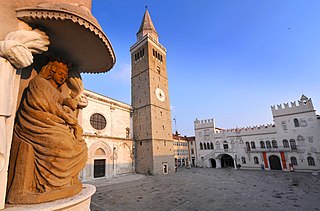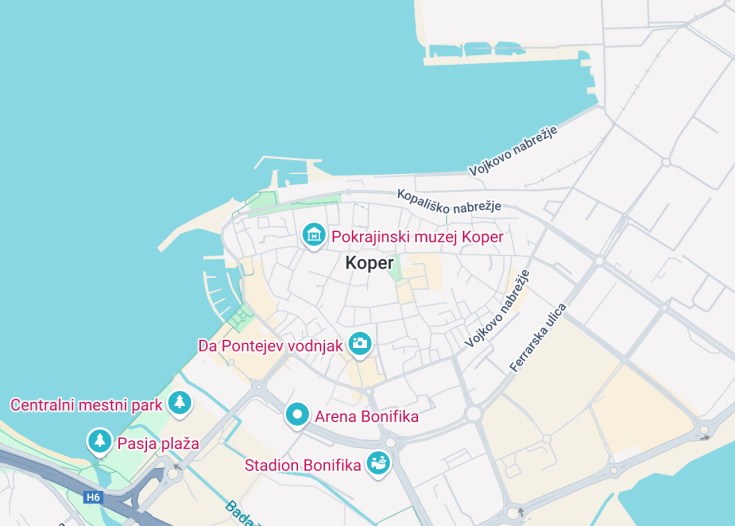Perched on the Istrian Peninsula’s coast, Koper is a hidden gem in Slovenia’s scenic landscape, embodying a unique blend of rich history and present-day vibrancy. This city, with its Venetian-influenced architecture and bustling port, offers a captivating experience. Its historical old town, crowned by the impressive Bell Tower and Praetorian Palace, reveals a storied past of Venetian domination and medieval splendor. Koper isn’t just about antiquities; its contemporary appeal includes a lively seafood scene, cultural festivities, and access to Slovenia’s pristine beaches. A visit here promises a deep dive into a multifaceted cultural heritage, complemented by the warm, welcoming spirit of its locals.
While in Koper, make sure to explore the old town’s narrow streets by foot to truly appreciate its hidden corners and architectural details.
Plan your visit in late spring or early autumn to enjoy Koper’s outdoor attractions and events comfortably, avoiding the peak summer crowds.
Top things to do & see in Koper
Select the following sights and activities to discover best tickets and tours available in Koper.
Koper: The Coastal Jewel of Slovenia
| Country | Slovenia |
| Time in Koper | GMT+1 |
| Language spoken | Slovenian |
| Population | 25,319 (source: Statistical Office of the Republic of Slovenia, 2021) |
| Currency | Euro (€, EUR) |
| Airports |
|
Koper, a city located on Slovenia’s Adriatic coastline, brims with historical significance and vibrant cultural heritage. With its roots stretching back to the ancient Greek period, Koper has been shaped by various cultural influences, evident in its architecture and local customs.
A walk through Koper reveals a blend of Gothic, Renaissance, and Baroque architectural styles, particularly evident in landmarks like the Praetorian Palace and the Bell Tower, both located in Tito Square, the city’s historical heart. The city’s Venetian-era influence is perhaps most palpable, having been under Venetian rule for centuries.
Today, Koper is not only a historical gem but also a dynamic part of Slovenia, known for its university, vibrant arts scene, and as an important industrial and shipping center. The Port of Koper is one of the Adriatic Sea’s key entrances and is integral to trade and transportation in the region.
Koper is also a gateway to exploring the istrian Peninsula, known for its lush landscapes and fine cuisine, which blends Italian and Slovenian influences. Local culinary delights include seafood specialities, truffle dishes, and famed Istrian wines like Malvasia and Refosco.
Despite its modernization and economic significance, Koper retains a relaxed charm, with locals prioritizing quality of life. The Mediterranean influence is evident in the local lifestyle, particularly in the slower pace and emphasis on enjoying life, which can be seen during the siesta-like closures in the early afternoons.
For those looking to explore Slovenian culture in a less touristy setting compared to Ljubljana or Lake Bled, Koper offers a unique blend of history, culture, and modern convenience, making it a must-visit destination in Slovenia.
Where is Koper?
Koper is situated along the northern part of the Adriatic Sea, in southwestern Slovenia, just a stone’s throw from the Italian border and the Gulf of Venice.
Distances:
| Route | Distance by car | Time by car |
|---|---|---|
| Ljubljana to Koper | 105 km | Approx. 1 hour 10 minutes |
| Trieste to Koper | 25 km | Approx. 30 minutes |
| Zagreb to Koper | 250 km | Approx. 2 hours 45 minutes |
| Vienna to Koper | 510 km | Approx. 5 hours |
What is Koper famous for?
Koper is renowned for its rich historical tapestry, blending the architectural and cultural influences of the Venetian Republic and Italy. It’s also known for its vibrant port, academic institutions, and a charming old town center.
History
Prehistoric Era to Roman Rule
The area now known as Koper was initially inhabited by Illyrian and Celtic tribes, who were known for their skills in agriculture and metalworking. These groups were later absorbed or displaced by the Romans who, after their arrival in the 2nd century BC, established the city as a strategic port and named it Capris. During Roman rule, the city flourished economically and culturally, setting a strong foundation for its future development.
Medieval Renaissance: 789-1420
With the fall of the Roman Empire, Koper came under the control of various rulers, including the Byzantine Empire and the Franks. In the early medieval period, Koper was granted city rights and began to establish a system of self-governance. In 789 AD, under the Frankish rule, Koper was mentioned as an important commercial and maritime hub. Later, it became a crucial part of the Venetian Empire, which left a lasting architectural and cultural imprint on the city.
Under Venetian Influence: 1420-1797
The Venetian period marked a golden era for Koper, as it became one of the most important ports in the Adriatic Sea. The city’s architecture, language, and culture were heavily influenced by Venice. Significant buildings from this period, such as the Praetorian Palace and the city’s narrow, winding streets, still define the character of Koper today. Despite occasional attacks and plagues, Koper continued to thrive as a center of trade and craftsmanship.
Napoleonic and Habsburg Rules: 1797-1918
After the fall of the Venetian Republic, Koper was conquered by Napoleon’s forces and became part of the Illyrian Provinces. This period was short-lived but pivotal, introducing reforms that modernized the region. After the Congress of Vienna, Koper, then known by its Italian name Capodistria, became part of the Austrian Empire, and later Austria-Hungary, marking a period of economic and infrastructure development.
20th Century Onwards
The 20th century was tumultuous for Koper, which saw governance transitions from the Austro-Hungarian Empire to Italy and finally Yugoslavia after World War II. This period saw significant demographic changes and industrial development. Since Slovenia’s independence in 1991, Koper has developed into a modern city that preserves its rich historical tapestry while integrating contemporary advancements in commerce, technology, and tourism.
Visit Koper
What to See and Do in Koper, Slovenia
Explore the historic marvels of Koper, starting with the splendid Venetian Gothic Praetorian Palace. Wander through the old town’s labyrinthine streets to discover gems such as the Cathedral of St. Nazarius with its impressive bell tower offering panoramic views of the city. Dive into culture at the Regional Museum of Koper, then relax at coffee shops along Čevljarska Street. For a touch of nature, visit the nearby Skocjan Caves, a UNESCO World Heritage site.
- Praetorian Palace
- Cathedral of St. Nazarius
- Regional Museum of Koper
- Skocjan Caves
Festivities in Koper
Koper hosts a variety of events year-round, celebrating its rich cultural tapestry. The Summer Carnival, held in July, transforms the city with vibrant parades and costumes. The Koper Wine and Olive Oil Festival in September showcases local culinary delights, while December’s Christmas Market offers festive cheer with crafts, food, and performances.
Best Time to Visit Koper
The ideal times to visit Koper are late spring (May and June) when the weather is warm but not yet hot, and early fall (September and October), when the summer crowds have thinned and the Adriatic Sea remains welcoming.
Is Koper Worth Visiting?
Koper is undoubtedly worth visiting for its rich blend of historical sights, cultural vibrancy, and beautiful seaside location. With its unique blend of Venetian influence and modern Slovenian culture, Koper provides a delightful mix of experiences for any traveler seeking to extend their knowledge and enjoyment of the Adriatic coast.










